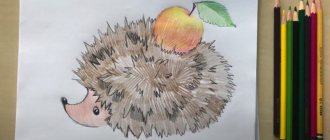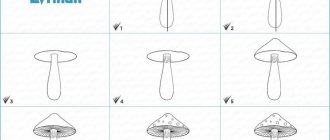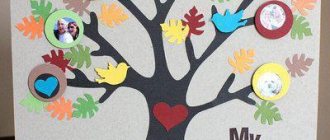Summary of GCD for drawing in non-traditional techniques (blotography) in the junior group
SUMMARY of educational activities in the second junior group “We are wizards” (non-traditional drawing technique: blotography)
Topic: “We are wizards” Goal: development of creative abilities. Objectives: Educational: • To introduce parents and children to one of the non-traditional techniques of drawing, blotography, to show its expressive capabilities; • show children the possibility of obtaining images using air and a tube; • learn to complete the details of objects (blots, to give them completeness and similarity with real images; • learn to see the unusual in the ordinary; Developmental: • develop imaginative thinking, imagination, fantasy, interest in creative activities. • develop color perception, sense of composition, ability to do conclusions • develop the respiratory system Educational: • Cultivate accuracy in painting with paints, • Cultivate a respectful attitude towards each other in teamwork Methods used: • Verbal: guessing riddles • Practical: finger gymnastics “Spring has come” • Equipment: Gouache paints, paint brushes, album sheets, napkins, jars of water, disposable spoons; tape recorder, audio recording “Spring” (Seasons) by A. Vivaldi. “...The more skill in a child’s hand, the smarter the child.”
(V.A. Sukhomlinsky )
Introduction: The formation of a creative personality is one of the important tasks of pedagogical theory and practice at the present stage.Its development begins more effectively from preschool age.
The more a child sees, hears, experiences, the more significant and productive the activity of his imagination will become. Working with non-traditional image techniques stimulates positive motivation, causes a joyful mood, removes fear of the drawing process, and is the most important means of aesthetic education. Blotography. This drawing technique is based on a regular blot. During the drawing process, spontaneous images are first obtained. With the help of blots and a flow of air, unusual silhouettes appear, which artists then turn into trees, fairy-tale characters, flowers and much more. Then the child draws in the details to make it complete and similar to the real image. It turns out that a blot can also be a way of drawing, for which no one will scold, but, on the contrary, will also be praised. Progress of the lesson
1. Organizational part The music is played by A. Vivaldi “Spring” from the cycle “Seasons” Teacher:
Guys!
Guess the riddle: She comes with affection and her fairy tale. He will wave his magic wand, and the snowdrop will bloom in the forest. (spring)
Guys, what magical objects does spring have?
what other magical objects do you know? (children's answers
) Do you think wizards exist?
Today you and I will turn into wizards, and our cocktail straws will become our magic wands. I suggest you use our magic wand to draw on paper and not just draw, but blow out a drawing. But first, you and I will practice. Try to draw an imaginary sun using a straw and air blown out by you. (children are drawing) (The teacher dips the brush in paint and makes a blot on a sheet of paper.)
A drop fell from the brush, It was the blot that came running, it bewitched everything around, both trees and bushes, and we will disenchant.
3. Explanation and demonstration: - We will draw flowers using our magic wand - a tube. First, dilute the gouache with water on the palette. Then we’ll take the paint with a brush and make a blot in the place where our flowers will be. Using a straw, we begin to inflate the blot without touching either the paint or the paper. The leaf can be rotated to create petals. We will draw the stems using our brushes. — Who can tell us what kind of paint we can use to paint flowers? and for drawing stems? ( Children's answers)
.
Before we begin, let's stretch our fingers. Finger gymnastics “Spring has come!” The woodpeckers are knocking louder and louder, the chickadees began to sing ( we put our palms together and pretend to have a “beak”, now opening and now closing it)
.
The sun rises early to warm our earth ( spread the fingers on both hands like rays of the sun)
The streams are running downhill, all the snow has melted,
(wave-like movements of the palms, the palm looks down on the table)
And from under the old grass a flower is already looking...
(palms connect and open slightly, bend your fingers halfway to form a cup of a flower)
The bell opened in the shade where the pine tree is, (
we open our flower)
Ting-ding, it rings quietly, Ting-ding, spring has come.
(sway our flower from side to side) Guys, what needs to be done to make the drawing beautiful? You need to try hard and do the drawing with love. - Get to work. 4. Summary of the lesson: Let's see what we got? What beautiful flowers! Did you like drawing with magic wands? What's your mood now? Photos from the lesson
We recommend watching:
Fine Arts lesson notes. Non-traditional drawing technique in the 1st junior group on the topic: New Year Summary of an art lesson in the 1st junior group. Unconventional drawing technique. Autumn tree Drawing based on the animated film "Boniface's Vacation" for children 4-6 years old. Master class with photos of non-traditional drawing techniques on the topic: Winter for children of the younger group
Similar articles:
Blotography in kindergarten
Rainbow-talents.RF
author: Pavlenkova Elena Dmitrievna
Teacher of MBDOU No. 141 “Ladushki”, Dzerzhinsk
Notes on drawing in the first junior group “Apples for the Bunny”
Notes on drawing in the first junior group.
"Apples for the Bunny"
Tasks:
- Educational:
give the concept of fruits; continue to introduce children to round objects. - Developmental:
develop the ability to draw round objects (apples); develop the ability to hold a brush correctly and dip it in paint; remove excess paint on the edge of the jar; Rinse the brush in water and dry. - Educational:
to instill in children an interest in the results of their work.
Preliminary work:
looking at illustrations and pictures of apples; reading a poem about apples, fruits; guessing riddles about fruits; examining a real apple and its replica.
Materials:
green gouache paint; sheets of paper with the image of a bag; real apple; dummies of apples; containers with water; brushes; napkins; oilcloth.
PROGRESS
There is a knock on the door, a little bunny comes in and asks you to help him collect apples in a bag. Bunny:
Hello guys! It's time to harvest, I need to collect all the apples in a bag, but I can't do it alone.
Will you help me? Educator:
Guys, let's help the bunny collect apples in a bag?
Children:
Yes, we will help!
The teacher shows the children apples. Educator:
Guys, look at the tray, what is on it?
Children:
Apples.
Educator:
Well done! Find and show a real apple.
(Children find a real apple).
Educator:
Look and tell me what shape is the apple?
Children:
Round.
Educator:
What color is the apple?
Children:
Green color.
Educator:
Take the apple in your hands and circle it with your index finger.
Now put the apple on the tray and draw it in the air with your finger.
Educator:
And now, guys, as we promised the bunny, we will draw apples in a bag.
Educator:
Let's go to the tables.
The teacher shows the children the “bags” (templates) that the bunny brought.
Guys, look at these bags.
We will draw apples in them. The teacher shows techniques for drawing potatoes in the outline of a bag in his teaching drawing:
- I take a brush and dip its bristles into a jar of water. I will remove the excess water from the pile on the edge of the jar.
- I dip the tip of the brush bristles into the gouache.
- Now I will draw round apples in a bag.
Educator:
Guys, let's “fill” the bags with apples, that is, draw apples in the bags.
Children draw apples on templates with green gouache.
Bunny:
Thank you guys for helping me collect all the apples in bags.
The bunny says goodbye to the children and leaves.
Educator:
Well done boys!
Help the bunny! The teacher praises the children and gives a positive assessment of each work.
Summary of GCD in the junior group of preschool educational institutions on the topic: Fairy tales
Summary of GCD in the younger group on the topic: “My favorite fairy tale”
Author: Gulnara Ruslanovna Kurmanova, teacher, Municipal Autonomous Preschool Educational Institution "Child Development Center - Kindergarten "Solnyshko" of the Yarkovsky Municipal District"
Description : This material is useful for preschool teachers and for teachers of additional education. The material is intended for working with children of the younger group. Goal: consolidating knowledge of fairy tales, expanding vocabulary, fostering a love of reading, respect for books, a friendly attitude towards each other, developing readiness for joint activities with adults. Objectives: - to consolidate the ability to compose descriptive stories, to promote the development of imagination. -develop memory and thinking; -to form a desire to perform independent game actions; -develop artistic perception, artistic and creative abilities. Equipment and materials
: costumes for turnips, cut pictures, leaves, pencils.
GCD progress:
Children sit on chairs in a semicircle (play area). Educator: There are many fairy tales in the world. Mothers and children read them! Good wins in a fairy tale, Animals come to life in a fairy tale! Guys, today we will talk to you about fairy tales. Do you like reading fairy tales? (Children's answers). Today we will take you into the world of fairy tales. Now we will remember some fairy tales. Quiz "In the world of fairy tales." 1. Once upon a time there was a grandfather and a woman, and they had a Chicken... (Ryaba) 2. Don’t sit on a stump, don’t eat the pie! Bring it to grandma, bring it to grandpa! Who said this? (Masha to the bear) 3. Mixed with sour cream, chilled on the window. Who is this? (Kolobok) 4. Open the door, your mother has come and brought milk. Who sang it? (Mother Goat to her little goats) 5. I am a little mouse, I am a frog, a frog...From what fairy tale? (Teremok) 6. A bug for a granddaughter, a granddaughter for a grandmother, a grandmother for a grandfather. From what fairy tale? (Turnip) Well done, guys! The next game is “Give me a word.” 1. What song did Kolobok sing? 2. What did the Ryaba Hen say to the grandfather and woman when the mouse broke the egg? 3. Who helped the bunny drive the fox out of his house? 4. What were the names of the three little pigs? 5. Whose house did Mashenka go to when she got lost in the forest? 6. Who did the Bug call to pull out the turnip? Well done, you know fairy tales very well! And now we will show you the fairy tale ourselves (a dramatization of the fairy tale “Turnip”). (those who wish go out, the rest watch). Now let’s rest a little and play with our fingers. Finger gymnastics (This finger is a grandfather, a gray bunny is sitting, a magpie is white-sided, a horned goat, we are chopping cabbage, there is a lock hanging on the door, a spider). Very good! We sit down at the tables. Game "Collect the picture." Now we will try to collect the picture and find out what fairy tale it depicts.
(Conditions of the game: children must collect a cut picture with an illustration from a fairy tale. Everyone collects and guesses which fairy tale). Well done, everyone did it! And, of course, we will draw your favorite characters! Everyone draws their favorite fairy tale hero (Kolobok). (Drawings for the exhibition) What did you like most? What's your mood? Very good! Thanks guys! Now you can play for yourself! (children go to play)
We recommend watching:
Theater in the 2nd junior group Do-it-yourself table theater based on Russian folk tales Class on describing toys in the junior group of the kindergarten Dramatization of a Russian folk tale in the preparatory group
Similar articles:
Synopsis of a physical education lesson in the junior group “Spring Puddles”
Summary of a lesson on speech development and modeling in junior group 1
Summary of educational activities on cognitive and speech development in the 1st junior group
Summary of a lesson on health conservation for the second junior group
Summary of an art lesson in junior group 1




